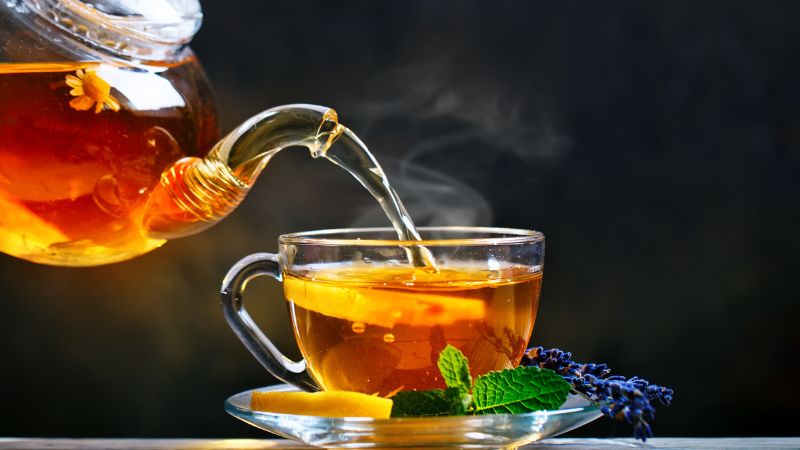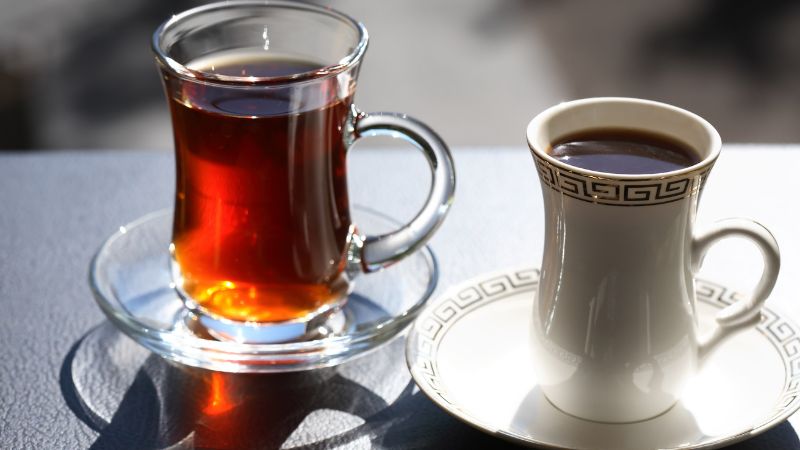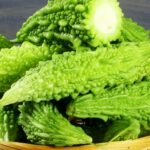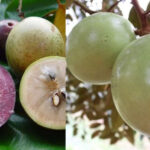For ages, tea and coffee have been popular beverages, beloved by many. The polyphenols found in tea and coffee not only boost alertness but also offer health and skincare benefits.
Polyphenols are natural compounds found in plants, including fruits, tea, coffee, and cacao. They are rich in antioxidants that protect the skin from free radical damage, stimulate collagen production, and slow down skin aging. While tea and coffee share these functions, they have distinct impacts on the skin. Join us as we explore which beverage is the better choice for your skin.
1 How Does Green Tea Affect the Skin?
Pros:
Tea contains catechins, a type of flavonoid polyphenol, which can protect the skin from oxidative stress and inflammation caused by UV rays. This helps prevent the breakdown of elastin and collagen – essential for maintaining skin firmness, elasticity, and a youthful appearance.
Catechins in tea also have a soothing effect on the skin, reducing irritation, redness, and swelling. This is especially beneficial for those with sensitive skin or skin conditions like acne or eczema.
 The impact of green tea on the skin
The impact of green tea on the skin
One of the most important catechins is EGCG (epigallocatechin gallate), commonly used in anti-aging cosmetics for its ability to improve elasticity, slow down aging, smoothen skin texture, and moisturize.
Numerous studies also indicate that EGCG has potential in preventing skin cancer. It can act as a potent shield against UV radiation, preventing premature aging and DNA damage.
All these compounds work together to protect the skin, moisturize from within, and prevent water loss, helping to avoid dryness and premature aging.
Tea contains less caffeine than coffee (approximately 25–100 mg), which helps reduce diuretic effects and enhances anti-inflammatory properties, effectively protecting the skin.
Cons:
Tea contains tannins, which interfere with iron absorption and may lead to iron-deficiency anemia if consumed in large quantities over an extended period. This condition not only causes fatigue and weakness but also results in dull, pale, and dry skin.
Additionally, tea contains caffeine, so if you’re sensitive to this stimulant, you may experience side effects such as restlessness, anxiety, or insomnia. Poor sleep quality due to tea consumption can also negatively impact your skin.
2 How Does Coffee Affect the Skin?
Pros:
Like tea, coffee is rich in phenolic acids, powerful antioxidants with significant anti-aging properties. These acids protect the skin from UV damage, prevent collagen degradation, and reduce the appearance of wrinkles.
The phenolic acids in coffee also exhibit strong anti-inflammatory properties, inhibiting the production of pro-inflammatory cytokines and enzymes. This is beneficial for those struggling with acne, psoriasis, eczema, or other inflammatory skin conditions.
The caffeine in coffee offers multiple skin benefits due to compounds like chlorogenic acid and melanoidin. These compounds support the antioxidant system, neutralizing free radicals and protecting the skin.
Furthermore, caffeine dilates blood vessels, increasing blood flow and improving circulation. Enhanced blood circulation delivers more nutrients and oxygen to the skin, keeping pores clear and the complexion bright and healthy.
With a higher caffeine content than tea (around 200 mg in coffee compared to 50 mg in tea), coffee has a more potent diuretic effect. This aids the body in detoxifying, reducing the likelihood of acne and other skin issues.
 Coffee’s impact on the skin
Coffee’s impact on the skin
Cons:
While coffee can offer skin benefits, excessive consumption may lead to premature aging signs, such as dull, lackluster, and sagging skin. With a higher caffeine content than tea, coffee is more likely to cause restlessness, anxiety, or insomnia, especially in individuals sensitive to caffeine. Sleep deprivation can result in wrinkle formation and dull, tired-looking skin.
The diuretic effect of coffee aids in toxin removal but can also cause dehydration due to increased urine production. When the skin becomes dehydrated, it may turn dry, flaky, itchy, and wrinkled due to a loss of elasticity.
3 Tea or Coffee: Which Is the Better Choice?
The choice between tea and coffee ultimately depends on personal preference, as both offer significant health benefits alongside some manageable drawbacks. Whether you favor tea or coffee, moderation is key to achieving optimal results.
If a choice must be made, according to researchers from the Beijing Union Medical College, drinking coffee regularly may effectively reduce the risk of facial aging.
 Both tea and coffee offer certain benefits for health and beauty
Both tea and coffee offer certain benefits for health and beauty
This study involved over 16,000 participants, mostly aged 45 to 65, and collected data on their facial aging status. By analyzing the relationship between the consumption of four beverages (tea, coffee, alcoholic drinks, and sugary drinks) and facial aging, the researchers found that only coffee significantly reduced the risk of facial aging.
Specifically, drinking coffee lowered the odds of facial aging by 15%. This suggests that regular coffee drinkers have a lower risk of facial aging and tend to look younger than non-coffee drinkers.
We hope that with the information we’ve shared about tea and coffee, you can make an informed choice to protect your health and beauty. It’s best to combine your beverage of choice with a healthy diet and lifestyle for optimal results.
The Secret to Choosing a Juicy, Sweet, and Thin-Skinned Sapodilla
Vú sữa is a popular fruit among many, but choosing a sweet and tasty one is no easy task. The art of selecting the perfect Vú sữa lies in a few key indicators; a keen eye and gentle touch will help you uncover the secrets to a delicious find.
The fruit’s appearance speaks volumes; a ripe Vú sữa boasts a vibrant yellow hue, with a hint of green at the stem. Its fragrance is another tell-tale sign, emitting a subtle, sweet aroma when ready to be enjoyed. But the true test of a Vú sữa’s ripeness is in its feel. A gentle squeeze will reveal a slight give, indicating the fruit is at its prime, ready to be savored.
With these simple tricks, you’ll be on your way to becoming a Vú sữa connoisseur, impressing your friends and family with your ability to select the finest fruits.



































